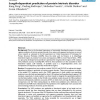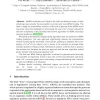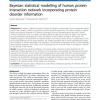508 search results - page 50 / 102 » A graphical model for protein secondary structure prediction |
BMCBI
2008
13 years 9 months ago
2008
Background: Prediction of disulfide bridges from protein sequences is useful for characterizing structural and functional properties of proteins. Several methods based on differen...
BMCBI
2010
13 years 9 months ago
2010
nd: Although methods based on highly abstract descriptions of protein structures, such as VAST and TOPS, can perform very fast protein structure comparison, the results can lack a...
BMCBI
2006
13 years 9 months ago
2006
Background: Due to the functional importance of intrinsically disordered proteins or protein regions, prediction of intrinsic protein disorder from amino acid sequence has become ...
RECOMB
2006
Springer
14 years 9 months ago
2006
Springer
mRNA molecules are folded in the cells and therefore many of their substrings may actually be inaccessible to protein and microRNA binding. The need to apply an accessability crite...
BMCBI
2010
13 years 9 months ago
2010
Background: We present a statistical method of analysis of biological networks based on the exponential random graph model, namely p2-model, as opposed to previous descriptive app...



